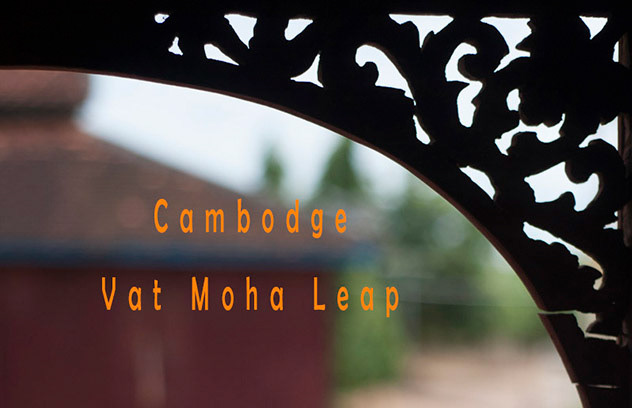
VAT MOHA LEAP
Une merveille de l’architecture bouddhique cambodgienne
Le Cambodge compte plusieurs milliers de pagodes à travers le pays, mais les temples historiques, antérieurs au XIXème siècle, sont rares.
En effet, pendant des siècles ces bâtiments étaient construits en bois. Le climat tropical du Cambodge rendait ce matériau très périssable et le temps aura eu raison d’eux, faute aussi d’un entretien suffisant. Par ailleurs, la terrible parenthèse des Khmers Rouge aura fini de les anéantir, un très grand nombre de pagode ayant été détruites pendant cette période. Le protectorat français apporta le béton armé à la fin du XIXème siècle, et les pagodes seront désormais bâties de ce matériau. La pagode du vat Moha Leap, dans la région de Kampong Cham aura résisté ; elle aurait été utilisée comme hôpital par les Khmers Rouges, et cette occupation l’aura sans doute sauvée.
D’après Danielle et Dominique-Pierre Gueret, auteurs d’une monumentale recherche sur les monuments d’architecture religieuse au Cambodge, le vat Moha Leap est très certainement le seul temple entièrement construit en bois qui subsisterait aujourd’hui dans le pays. Ils le datent antérieurement à 1880. Il a fait l’objet d’une rénovation récemment achevée. Nous avons eu l’honneur d’être sans doute parmi les tout premiers visiteurs à le découvrir dans toute sa splendeur, à l’été 2017.
Depuis Kompong Cham, après plus de deux heures de tuk tuk sur des pistes en latérite traversant d’immenses forêts d’hévéa, nous atteignons le village sur la rive du Tonlé Touch, affluent du Mékong.
La pagode semble désertée en cette fin de matinée du mois d’aout. Nous rencontrons par chance trois jeunes garçons qui trouvent les clefs et nous ouvrent le vihara. À l’intérieur, nous sommes émerveillés par une forêt de poteaux en teck, peints en noir et décorés de motifs au pochoir en or. Ils soutiennent l’énorme charpente et divisent le bâtiment en cinq nefs. Chacun serait fait d’un seul tronc de teck. Les peintures des pannes et chevrons, ainsi que celles du plafond sont d’origine.












VAT MOHA LEAP
A marvel of Cambodian Buddhist architecture
A marvel of Cambodian Buddhist architecture
Cambodia has several thousand pagodas across the country, but historic temples, dating from before the 19th century, are rare.
Indeed, for centuries these buildings were built of wood. The tropical climate of Cambodia made this material very perishable and time will have gotten the better of them, also due to lack of sufficient maintenance. Furthermore, the terrible parenthesis of the Khmer Rouge will have finished annihilating them, a very large number of pagodas having been destroyed during this period. The French protectorate brought reinforced concrete at the end of the 19th century, and pagodas will henceforth be built from this material. The Wat Moha Leap pagoda, in the Kampong Cham region, will have resisted; it would have been used as a hospital by the Khmer Rouge, and this occupation will undoubtedly have saved it.
According to Danielle and Dominique-Pierre Gueret, authors of monumental research on monuments of religious architecture in Cambodia, Wat Moha Leap is most certainly the only temple built entirely of wood that remains today in the country. They date it before 1880. It was the subject of a recently completed renovation. We had the honor of undoubtedly being among the very first visitors to discover it in all its splendor, in the summer of 2017.
From Kompong Cham, after more than two hours of tuk tuk on laterite tracks crossing immense rubber forests, we reach the village on the bank of the Tonlé Touch, a tributary of the Mekong.
The pagoda seems deserted at the end of this August morning. We luckily meet three young boys who find the keys and open the vihara for us. Inside, we marvel at a forest of teak posts, painted black and decorated with gold stenciled designs. They support the enormous framework and divide the building into five naves. Each would be made from a single teak trunk. The paintings on the purlins and rafters, as well as those on the ceiling, are original.
Indeed, for centuries these buildings were built of wood. The tropical climate of Cambodia made this material very perishable and time will have gotten the better of them, also due to lack of sufficient maintenance. Furthermore, the terrible parenthesis of the Khmer Rouge will have finished annihilating them, a very large number of pagodas having been destroyed during this period. The French protectorate brought reinforced concrete at the end of the 19th century, and pagodas will henceforth be built from this material. The Wat Moha Leap pagoda, in the Kampong Cham region, will have resisted; it would have been used as a hospital by the Khmer Rouge, and this occupation will undoubtedly have saved it.
According to Danielle and Dominique-Pierre Gueret, authors of monumental research on monuments of religious architecture in Cambodia, Wat Moha Leap is most certainly the only temple built entirely of wood that remains today in the country. They date it before 1880. It was the subject of a recently completed renovation. We had the honor of undoubtedly being among the very first visitors to discover it in all its splendor, in the summer of 2017.
From Kompong Cham, after more than two hours of tuk tuk on laterite tracks crossing immense rubber forests, we reach the village on the bank of the Tonlé Touch, a tributary of the Mekong.
The pagoda seems deserted at the end of this August morning. We luckily meet three young boys who find the keys and open the vihara for us. Inside, we marvel at a forest of teak posts, painted black and decorated with gold stenciled designs. They support the enormous framework and divide the building into five naves. Each would be made from a single teak trunk. The paintings on the purlins and rafters, as well as those on the ceiling, are original.




